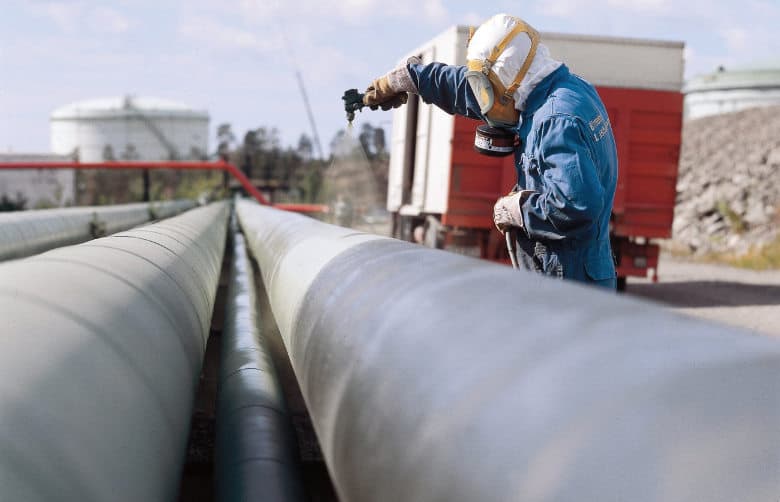The protective coating industry plays a central role in safeguarding various materials from the harsh effects of environmental exposure, corrosion, and wear.
Ensuring the integrity of these coatings is crucial to their performance and longevity. Among the common challenges faced by professionals in the industry are pinholes and porosity—two defects that can significantly compromise the effectiveness of protective coatings.
What is Pinhole?
A pinhole is a small, often microscopic, void that penetrates through the entire thickness of a coating, exposing the substrate underneath. These defects typically occur due to trapped air or gas that escapes during the drying or curing process, leaving behind a tiny cavity.
Meaning of Porosity
Porosity, on the other hand, refers to the presence of multiple small voids or gaps within the coating that may or may not extend through the entire layer. These voids can form due to various factors, including improper mixing of coating materials, rapid curing, or a contaminated surface.
Differences Between Pinhole and Porosity
While both pinholes and porosity involve empty spaces in the coating, their implications and causes differ.
Pinholes are often isolated and penetrate fully through the coating, posing a direct threat to the substrate by allowing moisture and corrosive elements to reach it.
Porosity, however, may be more widespread but does not necessarily breach the coating’s full thickness.
Despite this, porosity can still weaken the coating and provide pathways for moisture to enter.
Causes of Pinhole in Coatings
- Air Entrapment During Application
One of the primary causes of pinholes is air entrapment during the application process. If the coating is applied too quickly or with improper technique, air bubbles can become trapped within the material.
As the coating dries or cures, these bubbles rise to the surface and burst, leaving pinholes.
- Inadequate Surface Preparation
Surface preparation is essential in ensuring a defect-free coating. If the substrate is not properly cleaned or primed, contaminants such as dust, oils, or moisture can mix with the coating’s adhesion, leading to pinholes.
- High Application Thickness
Applying the coating in excessively thick layers can also lead to pinholes.
Thick coatings are more prone to trapping air, which can then escape during the curing process, creating voids.
- Environmental Factors
Environmental conditions, such as temperature and humidity, can significantly impact the formation of pinholes.
High temperatures can cause the coating to dry too quickly, trapping air bubbles before they can escape.
On the other hand, high humidity levels can introduce moisture into the coating, leading to defects.
Causes of Porosity in Coatings
- Improper Mixing of Coating Materials
Porosity often occurs when the coating materials are not mixed thoroughly. Incomplete mixing can result in uneven distribution of the components, leading to the formation of voids within the coating.
- Application Technique Issues
The use of incorrect application techniques, such as applying the coating at the wrong angle or with improper pressure, can result in uneven layers that are prone to porosity.
- Presence of Contaminants
Contaminants, whether on the substrate or within the coating material, can create areas of weakness in the coating. These weak points are more susceptible to porosity as the coating cures.
- Curing Problems
If the coating does not cure uniformly, areas with different densities can develop, leading to porosity. This issue is particularly common in coatings that require specific conditions for curing, such as precise temperature and humidity levels.
Impact of Pinhole and Porosity on Coating Performance
Risk of Corrosion
Both pinholes and porosity can expose the substrate to moisture and corrosive elements, significantly increasing the risk of corrosion. This is especially problematic in industries where metal substrates are common, as corrosion can lead to structural failure.
Decreased Durability
Coatings with pinholes or porosity are less durable and more prone to wear over time. The presence of these defects weakens the overall integrity of the coating, making it more susceptible to damage.
Compromised Barrier Protection
The primary function of protective coatings is to act as a barrier against environmental factors. Pinholes and porosity compromise this barrier, allowing harmful elements to penetrate and damage the substrate.
Preventive Measures for Pinhole Formation
- Optimised Application Techniques
To prevent pinholes, it is essential to use optimised application techniques. This includes applying the coating at the correct speed, pressure, and angle to minimise air entrapment.
- Proper Surface Preparation
Ensuring the substrate is clean, dry, and free of contaminants is crucial in preventing pinholes. Using a suitable primer can also improve adhesion and reduce the risk of defects.
Preventive Measures for Porosity Formation
- Ensuring Proper Mixing of Materials
Proper mixing of coating materials is vital to preventing porosity. This ensures that all components are evenly distributed, reducing the likelihood of voids forming within the coating.
- Using Suitable Application Methods
Applying the coating using suitable methods and equipment can minimise the risk of porosity. This includes using the correct spray nozzles, pressure settings, and application techniques.
- Regular Equipment Maintenance
Regular maintenance of application equipment is essential to prevent issues that can lead to porosity. This includes cleaning and inspecting tools and equipment to ensure they are functioning correctly.
The Role of Coating Inspection Kits in Addressing Pinhole and Porosity Defects
Early detection and prevention of defects like pinholes and porosity are crucial to ensuring the longevity and effectiveness of a coating.
This is where a Coating Inspection Kit becomes an indispensable tool for professionals. These kits are designed to help inspectors and applicators identify potential issues before they become major problems, ensuring that coatings meet industry standards and provide the necessary protection.
How Elcometer Coating Inspection Kits Help
As a trusted name in the industry, Elcometer offers a range of Coating Inspection Kits that are specifically designed to detect defects such as pinholes and porosity. These kits include advanced tools that allow for thorough inspection of coatings at various stages of the application process.
-Pinhole Detectors: Elcometer’s pinhole detectors are essential for identifying pinholes that may not be visible to the naked eye. These detectors work by passing an electrical current over the coated surface, highlighting any breaches in the coating that could lead to corrosion.
– Porosity Testers: Elcometer’s porosity testers are designed to detect the presence of voids within a coating layer. By identifying areas of porosity early, professionals can take corrective action to prevent coating failure and ensure a uniform protective barrier.
– Environmental Monitoring Equipment: The kits also include tools for monitoring environmental conditions such as temperature and humidity, which are critical factors in preventing the formation of pinholes and porosity. By controlling these variables, applicators can ensure optimal curing and adhesion of the coating.
Some FAQs about Pinholes and Porosity
1. What are the most common causes of pinholes in coatings?
Pinholes are commonly caused by air entrapment during application, inadequate surface preparation, high application thickness, and environmental factors.
2. How can I detect porosity in a coating?
Porosity can be detected using visual inspection, ultrasonic testing, microscopic analysis, and by checking for curing problems.
3. What is the impact of pinhole defects on corrosion resistance?
Pinhole defects can significantly reduce corrosion resistance by allowing moisture and corrosive elements to reach the substrate.
4. Are there new technologies to prevent porosity?
Yes, advancements such as self-healing coatings, nano-coatings, and improved application tools are helping to prevent porosity in coatings.
5. How can coating professionals stay updated on industry standards?
Coating professionals can stay updated by participating in continuous education and training programs, obtaining certifications, and following industry publications and guidelines.
Marowin Engineering & Development Limited: Your Trusted Supplier
As a distributor of Elcometer products, Marowin Engineering & Development Limited is your go-to source for obtaining these essential inspection kits.
Whether you are working on a large-scale industrial project or a smaller, specialised application, Marowin can supply you with the Elcometer Coating Inspection Kits you need to achieve defect-free coatings.
Here’s what we offer you:
– Expert Consultation: Our team can provide guidance on selecting the right Elcometer Coating Inspection Kit for your specific project needs, ensuring you have the tools necessary to maintain the highest standards of coating integrity.
– Prompt Supply: We understand the critical timelines involved in coating projects. Marowin ensures that you receive your inspection kits promptly, allowing you to stay on schedule and avoid delays.
– After-Sales Support: We offer ongoing support to help you get the most out of your Elcometer equipment. Whether it’s answering questions about usage or assisting with maintenance, we’re here to help.
By integrating the use of Elcometer Coating Inspection Kits into your projects, you can significantly reduce the risk of defects like pinholes and porosity, ensuring that your protective coatings perform as expected. And with Marowin Engineering & Development Limited as your distributor, you have a reliable partner to support your coating inspection needs.
Incorporating Elcometer Coating Inspection Kits into your workflow not only helps in detecting and preventing pinholes and porosity but also ensures that your coatings perform as intended, providing long-lasting protection and reducing the risk of costly failures. Trust Marowin Engineering & Development Limited to equip you with the best tools for the job, helping you achieve superior results in your coating projects.


Recent Comments